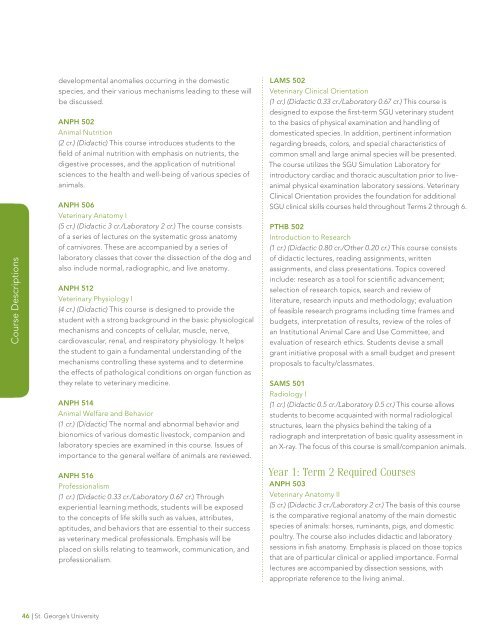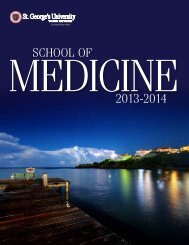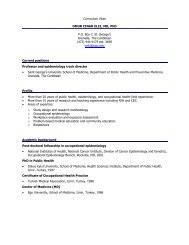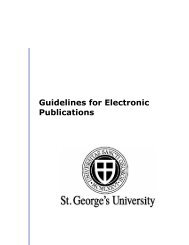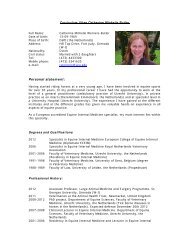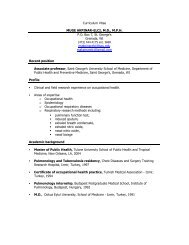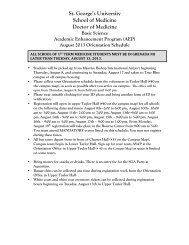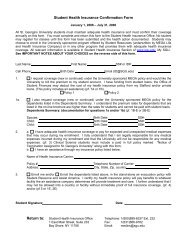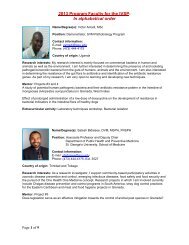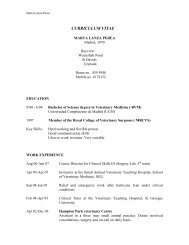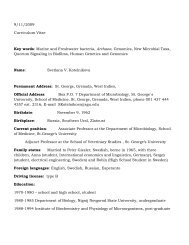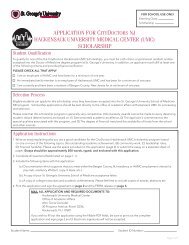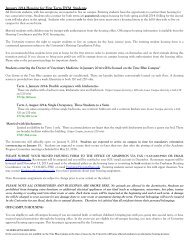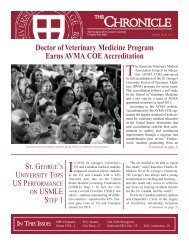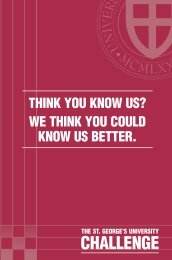SVM Catalogue 2012-2013 - St. George's University
SVM Catalogue 2012-2013 - St. George's University
SVM Catalogue 2012-2013 - St. George's University
Create successful ePaper yourself
Turn your PDF publications into a flip-book with our unique Google optimized e-Paper software.
School of Medicine<br />
Course Descriptions<br />
developmental anomalies occurring in the domestic<br />
species, and their various mechanisms leading to these will<br />
be discussed.<br />
AnPH 502<br />
Animal Nutrition<br />
(2 cr.) (Didactic) This course introduces students to the<br />
field of animal nutrition with emphasis on nutrients, the<br />
digestive processes, and the application of nutritional<br />
sciences to the health and well-being of various species of<br />
animals.<br />
AnPH 506<br />
Veterinary Anatomy I<br />
(5 cr.) (Didactic 3 cr./Laboratory 2 cr.) The course consists<br />
of a series of lectures on the systematic gross anatomy<br />
of carnivores. These are accompanied by a series of<br />
laboratory classes that cover the dissection of the dog and<br />
also include normal, radiographic, and live anatomy.<br />
AnPH 512<br />
Veterinary Physiology I<br />
(4 cr.) (Didactic) This course is designed to provide the<br />
student with a strong background in the basic physiological<br />
mechanisms and concepts of cellular, muscle, nerve,<br />
cardiovascular, renal, and respiratory physiology. It helps<br />
the student to gain a fundamental understanding of the<br />
mechanisms controlling these systems and to determine<br />
the effects of pathological conditions on organ function as<br />
they relate to veterinary medicine.<br />
AnPH 514<br />
Animal Welfare and Behavior<br />
(1 cr.) (Didactic) The normal and abnormal behavior and<br />
bionomics of various domestic livestock, companion and<br />
laboratory species are examined in this course. Issues of<br />
importance to the general welfare of animals are reviewed.<br />
AnPH 516<br />
Professionalism<br />
(1 cr.) (Didactic 0.33 cr./Laboratory 0.67 cr.) Through<br />
experiential learning methods, students will be exposed<br />
to the concepts of life skills such as values, attributes,<br />
aptitudes, and behaviors that are essential to their success<br />
as veterinary medical professionals. Emphasis will be<br />
placed on skills relating to teamwork, communication, and<br />
professionalism.<br />
LAMS 502<br />
Veterinary Clinical Orientation<br />
(1 cr.) (Didactic 0.33 cr./Laboratory 0.67 cr.) This course is<br />
designed to expose the first-term SGU veterinary student<br />
to the basics of physical examination and handling of<br />
domesticated species. In addition, pertinent information<br />
regarding breeds, colors, and special characteristics of<br />
common small and large animal species will be presented.<br />
The course utilizes the SGU Simulation Laboratory for<br />
introductory cardiac and thoracic auscultation prior to liveanimal<br />
physical examination laboratory sessions. Veterinary<br />
Clinical Orientation provides the foundation for additional<br />
SGU clinical skills courses held throughout Terms 2 through 6.<br />
PTHB 502<br />
Introduction to Research<br />
(1 cr.) (Didactic 0.80 cr./Other 0.20 cr.) This course consists<br />
of didactic lectures, reading assignments, written<br />
assignments, and class presentations. Topics covered<br />
include: research as a tool for scientific advancement;<br />
selection of research topics, search and review of<br />
literature, research inputs and methodology; evaluation<br />
of feasible research programs including time frames and<br />
budgets, interpretation of results, review of the roles of<br />
an Institutional Animal Care and Use Committee, and<br />
evaluation of research ethics. <strong>St</strong>udents devise a small<br />
grant initiative proposal with a small budget and present<br />
proposals to faculty/classmates.<br />
SAMS 501<br />
Radiology I<br />
(1 cr.) (Didactic 0.5 cr./Laboratory 0.5 cr.) This course allows<br />
students to become acquainted with normal radiological<br />
structures, learn the physics behind the taking of a<br />
radiograph and interpretation of basic quality assessment in<br />
an X-ray. The focus of this course is small/companion animals.<br />
Year 1: Term 2 Required Courses<br />
AnPH 503<br />
Veterinary Anatomy II<br />
(5 cr.) (Didactic 3 cr./Laboratory 2 cr.) The basis of this course<br />
is the comparative regional anatomy of the main domestic<br />
species of animals: horses, ruminants, pigs, and domestic<br />
poultry. The course also includes didactic and laboratory<br />
sessions in fish anatomy. Emphasis is placed on those topics<br />
that are of particular clinical or applied importance. Formal<br />
lectures are accompanied by dissection sessions, with<br />
appropriate reference to the living animal.<br />
46 | <strong>St</strong>. George’s <strong>University</strong>


